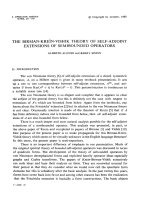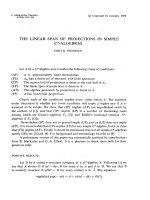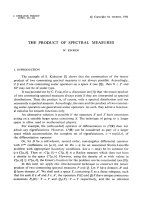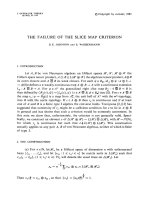Báo cáo toán học: "The polynomial part of a restricted partition function related to the Frobenius problem" pptx
Bạn đang xem bản rút gọn của tài liệu. Xem và tải ngay bản đầy đủ của tài liệu tại đây (88.15 KB, 5 trang )
The polynomial part of a restricted partition function
related to the Frobenius problem
Matthias Beck
Department of Mathematical Sciences
State University of New York
Binghamton, NY 13902–6000, USA
Ira M. Gessel
∗
Department of Mathematics
Brandeis University
Waltham, MA 02454–9110, USA
Takao Komatsu
Faculty of Education
Mie University
Mie, 514–8507, Japan
Submitted: May 29, 2001; Accepted: September 4, 2001
MR Subject Classifications: Primary 05A15; Secondary 11P81, 05A17
Abstract
Given a set of positive integers A = {a
1
, ,a
n
}, we study the number p
A
(t)of
nonnegative integer solutions (m
1
, ,m
n
)to
n
j=1
m
j
a
j
= t. We derive an explicit
formula for the polynomial part of p
A
.
Let A = {a
1
, ,a
n
} be a set of positive integers with gcd(a
1
, ,a
n
)=1. The
classical Frobenius problem asks for the largest integer t (the Frobenius number)such
that
m
1
a
1
+ ···+ m
n
a
n
= t
has no solution in nonnegative integers m
1
, ,m
n
.Forn = 2, the Frobenius number is
(a
1
− 1)(a
2
− 1) − 1, as is well known, but the problem is extremely difficult for n>2.
(For surveys of the Frobenius problem, see [R, Se].) One approach [BDR, I, K, S
¨
O] is to
study the restricted partition function p
A
(t), the number of nonnegative integer solutions
(m
1
, ,m
n
)to
n
j=1
m
j
a
j
= t,wheret is a nonnegative integer. The Frobenius number
is the largest integral zero of p
A
(t). Note that, in contrast to the Frobenius problem, in
the definition of p
A
we do not require a
1
, ,a
n
to be relatively prime. In the following,
a
1
, ,a
n
are arbitrary positive integers.
∗
Research partially supported by NSF grant DMS-9972648.
the electronic journal of combinatorics 8 (2001), #N7 1
It is clear that p
A
(t) is the coefficient of z
t
in the generating function
G(z)=
1
(1 − z
a
1
) ···(1 − z
a
n
)
.
If we expand G(z) by partial fractions, we see that p
A
(t) can be written in the form
λ
P
A,λ
(t)λ
t
,
where the sum is over all complex numbers λ such that λ
a
i
= 1 for some i,andP
A,λ
(t)is
a polynomial in t. The aim of this paper is to give an explicit formula for P
A,1
(t), which
we denote by P
A
(t)andcallthepolynomial part of p
A
(t). It is easy to see that P
A
(t)is
a polynomial of degree n − 1. (More generally, the degree of P
A,λ
(t) is one less than the
number of values of i for which λ
a
i
= 1.) It is well known [PS, Problem 27] that
p
A
(t)=
t
n−1
(n − 1)! a
1
···a
n
+ O
t
n−2
.
Our theorem is a refinement of this statement. We note that Israilov derived a more
complicated formula for P
A
(t)in[I].
Let us define Q
A
(t)byp
A
(t)=P
A
(t)+Q
A
(t). From the partial fraction expansion
above, it is clear that Q
A
(and hence also p
A
)isaquasi-polynomial, that is, an expression
of the form
c
d
(t)t
d
+ ···+ c
1
(t)t + c
0
(t),
where c
0
, ,c
d
are periodic functions in t. (See, for example, Stanley [St, Section 4.4],
for more information about quasi-polynomials.) In the special case in which the a
i
are
pairwise relatively prime, each P
A,λ
(t) for λ = 1 is a constant, and thus Q
A
(t)isa
periodic function with average value 0, and this property determines Q
A
(t), and thus
P
A
(t). Discussions of Q
A
(t) can be found, for example, in [BDR, I, K].
We define the Bernoulli numbers B
j
by
z
e
z
− 1
=
j≥0
B
j
z
j
j!
(1)
(so B
0
=1,B
1
= −
1
2
,B
2
=
1
6
,B
4
= −
1
30
,andB
n
=0ifn is odd and greater than 1.)
Theorem.
P
A
(t)=
1
a
1
···a
n
n−1
m=0
(−1)
m
(n − 1 − m)!
k
1
+···+k
n
=m
a
k
1
1
···a
k
n
n
B
k
1
···B
k
n
k
1
! ···k
n
!
t
n−1−m
(2)
=
1
a
1
···a
n
n−1
m=0
(−1)
m
(n − 1 − m)!
×
k
1
+2k
2
···+mk
m
=m
(−1)
k
2
+···+k
m
k
1
! ···k
m
!
B
1
s
1
1 · 1!
k
1
···
B
m
s
m
m · m!
k
m
t
n−1−m
, (3)
the electronic journal of combinatorics 8 (2001), #N7 2
where s
i
= a
i
1
+ ···+ a
i
n
.
As an intermediate step, we first prove the following more elegant but less explicit
formula for P
A
(t).
Proposition. P
A
(t) is the constant term in z in
−
ze
−tz
(1 − e
a
1
z
) ···(1 − e
a
n
z
)
.
Proof. As noted earlier, p
A
(t) is the coefficient of z
t
in the generating function
G(z)=
1
(1 − z
a
1
) ···(1 − z
a
n
)
.
Hence if we let f(z)=G(z)/z
t+1
then p
A
(t)=Res(f(z),z = 0). As in [BDR], we use the
residue theorem to derive a formula for p
A
(t). Since clearly lim
R→∞
|z|=R
f(z) dz =0,
p
A
(t)=− Res(f(z),z =1)−
Res(f(z),z = λ).
Here the sum is over all nontrivial a
1
, ,a
n
th roots of unity λ. It is not hard to see
that Res(f(z),z = λ) may be expressed in the form u
λ
(t)λ
−t
for some polynomial u
λ
(t),
and thus it follows from our earlier discussion that − Res(f(z),z = λ)=P
A,λ
−1
(t)λ
−t
.In
particular,
P
A
(t)=− Res(f(z),z =1).
To compute this residue, note that
Res(f(z),z =1)=Res(e
z
f(e
z
),z =0),
so that
P
A
(t)=− Res
e
−tz
(1 − e
a
1
z
) ···(1 − e
a
n
z
)
,z =0
. (4)
✷
Proofofthetheorem.The coefficient of t
n−1−m
in P
A
(t) is by (4) the coefficient of z
−n+m
in
(−1)
n−m
(n − 1 − m)!
·
1
(1 − e
a
1
z
) ···(1 − e
a
n
z
)
,
which is the coefficient of z
m
in
(−1)
m
(n − 1 − m)! a
1
···a
n
B(a
1
z) ···B(a
n
z), (5)
where B(z)=z/(e
z
− 1), and this implies (2).
Toprove(3),wefirstnotethat
log
z
e
z
− 1
=
j≥1
(−1)
j−1
B
j
j
z
j
j!
,
the electronic journal of combinatorics 8 (2001), #N7 3
as can easily be proved by differentiating both sides. Then
B(a
1
z) ···B(a
n
z)=exp
j≥1
(−1)
j−1
B
j
s
j
j
z
j
j!
=
j≥1
exp
(−1)
j−1
B
j
s
j
j
z
j
j!
. (6)
Since B
2i+1
= 0 for i>0, (−1)
j−1
B
j
= −B
j
for j>1, and (3) follows from (5) and (6).
✷
Remark. It is possible to avoid the use of complex analysis and give a purely formal power
series proof of the theorem. We indicate here how this can be done. We work with formal
Laurent series, which are power series with finitely many negative powers of the variable.
If F(z)=
i
u
i
z
i
is a formal Laurent series (u
i
is nonzero for only finitely many negative
values of i) then the residue of F (z)isresF (z)=u
−1
. An elementary fact about formal
Laurent series is the change of variables formula for residues: If g(z) is a formal power
series with g(0) = 0 and g
(0) =0then
res F (z)=resF (g(z))g
(z).
(See, for example, Goulden and Jackson [GJ, p. 15].)
By partial fractions, we have
G(z)=
1
(1 − z
a
1
) ···(1 − z
a
m
)
=
c
1
1 − z
+ ···+
c
m
(1 − z)
m
+ R(z),
where R(z) is a rational function of z with denominator not divisible by 1 − z. It follows
from our earlier discussion that
∞
t=0
P
A
(t)z
t
=
c
1
1 − z
+ ···+
c
m
(1 − z)
m
and thus
P
A
(t)=
∞
l=1
c
l
t + l − 1
l − 1
,
where we take c
l
to be 0 for l>m.NowletU(z)=G(1 − z). Then
U(z)=
1
(1 − (1 − z)
a
1
) ···(1 − (1 − z)
a
m
)
=
c
1
z
+ ···+
c
m
z
m
+ R(1 − z),
where R(1−z) has a formal power series expansion (with no negative powers of z), and thus
c
l
=resz
l−1
U(z). Note that this holds for all l ≥ 1, since for l>m, c
l
=resz
l−1
U(z)=0.
the electronic journal of combinatorics 8 (2001), #N7 4
Then
P
A
(t)=
∞
l=1
c
l
t + l − 1
l − 1
=res
U(z)
z
m
l=1
z
l
t + l − 1
l − 1
=res
U(z)
(1 − z)
t+1
.
We now apply the change of variables formula with g(z)=1− e
z
and we obtain
P
A
(t)=− res
U(1 − e
z
)
e
tz
= − res
e
−tz
(1 − e
a
1
z
) ···(1 − e
a
m
z
)
,
which is (4), and the proof continues as before.
References
[BDR] M. Beck, R. Diaz, S. Robins, The Frobenius problem, rational polytopes, and
Fourier–Dedekind sums, to appear in J. Number Theory.
[GJ] I. P. Goulden and D. M. Jackson, Combinatorial Enumeration, Wiley, New York,
1983.
[I] M. I. Israilov, Numbers of solutions of linear Diophantine equations and their appli-
cations in the theory of invariant cubature formulas, Sibirsk. Mat. Zh. 22 (1981), no. 2,
121–136, 237. English translation: Siberian Math. J. 22 (1981), no. 2, 260–273.
[K] T. Komatsu, The number of solutions of the Diophantine equation of Frobenius, to
appear in J. Th´eor. Nombres Bordeaux.
[PS] G. P
´
olya and G. Szeg
˝
o, Aufgaben und Lehrs¨atze aus der Analysis, Springer-Verlag,
Berlin, 1925.
[R] J. L. Ramirez Alfonsin, The diophantine Frobenius problem, Report No. 00893,
Forschungsinstitut f¨ur diskrete Mathematik, Universit¨at Bonn (2000).
[Se] E. S. Selmer, On the linear diophantine problem of Frobenius, J. reine angew. Math.
293/294 (1977), 1–17.
[S
¨
O] S. Sert
¨
oz, A.
¨
Ozl
¨
uk, On the number of representations of an integer by a linear form,
˙
Istanbul
¨
Univ. Fen Fak. Mat. Derg. 50 (1991), 67–77.
[St] R. P. Stanley, Enumerative Combinatorics, Vol. 1, Wadsworth & Brooks/Cole, Mon-
terey, California, 1986.
the electronic journal of combinatorics 8 (2001), #N7 5









